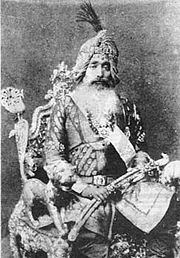1763–1948 → 1931 3,460 km (1,336 sq mi) Capital Sangrur | Established 1763 1931 324,676 | |
 | ||
Today part of Punjab & Haryana state of India | ||
Jind State was a Cis-Sutlej state princely state of India during the British Raj until India's independence in 1947.
Contents
The state was some 3,260 km2 (1,260 sq mi) in area and its annual income was Rs.3,000,000 in the 1940s.
History
The princely state of Jind & Sangrur was founded in 1763. The rulers belonged to the Phulkian dynasty. It was a Cis-Sutlej state, ruled by the Scindhia dynasty of the Maratha Empire, various small Punjabi kingdoms of the Cis-Sutlej states paid tributes to the Marathas, until the Second Anglo-Maratha War of 1803-1805, after which the Marathas lost this territory to the British. On 25 April 1809 Jind became a British protectorate. Gajpat Singh ruled under the title of raja until 1789, then Bhag Singh until 1819, Fateh Singh until 1822, and Sangat Singh until 1834. After a vacancy of three years, Sarup Singh ruled until 1864, succeeded by Raghubir Singh, who took the title Raja-i Rajgan in 1881. In 1887 he was succeeded by Ranbir Singh, who became Maharaja in 1911 and continued to rule the state until its accession to India in 1947. Ranbir Singh, last Ruler of Jind, was called Colonel His Highness Farzand-i-dilband Rasikh-ul-itikad Daulat-i-englishia Raja-i-rajgan Maharaja Sir Ranbir Singh Rajendra Bahadur.
On 20 August 1948, with the signing of accession to India, Jind became a part of the Patiala and East Punjab States Union and ceased to exist as a separate state. Jind town and district now form a part of Indian state of Haryana.
Postage stamps prior to King George V consisted of Indian stamps over printed as "Jhind State", with the letter 'H' in the name. On the George V stamps, the 'H' is omitted and is overprinted as "Jind State" (Reference actual stamps from the Victorian, Edward VII and George V eras).
Rulers of Jind
The rulers of the state bore the title of 'Raja' until 1881. They had the privilege of a 13-gun salute.
Claiming descent from Jaisal, founder of Jaisalmer State in 1156, the founder of this Sikh dynasty, Phul Singh, was Chaudhary (Governor) of a province to the south east of Delhi. Phul’s descendants founded three States: Patiala, Jind and Nabha. Phul had six sons, Tiloka Ram Singh, Rudh, Chunu, Jhandu, and Takhtmal. Tiloka had two sons, Gurudutta and Sukh Chain. Sukh Chain founded Jind, which was ruled by his descendants, while Gurudatta's descendants ruled Nabha State.
Rajas
Raja i Rajgan
Maharaja
12 Dec 1911 – 15 Aug 1947 Sir Ranbir Singh (s.a.)
